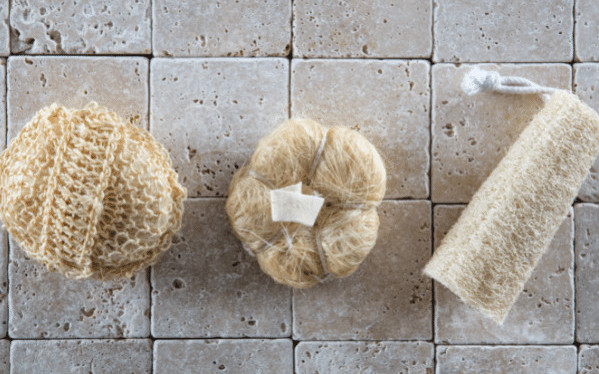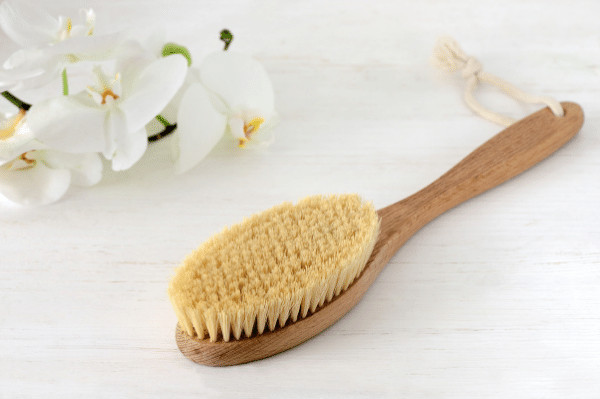What is dry brushing skin? Dry brushing your skin is as easy as it sounds. It is taking a bristled brush and sweeping it across the skin, beginning at the feet and working your way up towards the heart. It is called “dry” because it is done before a bath or a shower, while your body and skin are completely dry.
History of Dry Brushing
While “dry brushing” is relatively new today, it had its roots long ago. The Japanese, Greeks, and other cultures used skin brushing to beautify and cleanse the skin.
Dry Brushing as a Skin Care Routine
Dry brushing can be included as part of a body treatment package that is offered at day spas.
Some doctors recommend it as a good way to keep skin smooth and supple.
It is an easy to do treatment that can be done at home before taking a shower. All you need is a relatively inexpensive natural bristle brush, and maybe five minutes of your time!
The Benefits of Dry Brushing Your Skin
- Exfoliates your skin
- Improves circulation
- Your skin will look radiant and feel softer and smoother
- Relaxes and invigorates you. It just feels good on your skin!
- Helps in circulation of the lymphatic system.

Choosing the Right Brush
A dry brush should be easy to find. They are sometimes sold in the skincare aisle of big box stores, your local health food store, or you can buy them online.
Most dry brush experts recommend a natural bristle brush. Some are made from plant sources like jute or sisal.
A dry brush should not leave marks on your skin, and you definitely don’t want to see redness or abrasions. Dry brushing should feel good on your skin. It should not burn or sting. If it does not feel good, it may mean that your brush is too course, or you are being too aggressive in your brushing!

What to Look for When Purchasing a Dry Brush
- A small brush that fits in the palm of your hand makes it easy to reach your arms and body.
- A long handle makes it easier to dry brush your back and legs. Some brushes offer the best of both worlds with a removable handle. Check out the brush that is the most appealing to you.
- You will want a brush that is just firm enough to give you the best session, but not too course to leave marks or be uncomfortable. Avoid a brush with stiff, hard bristles.
- Use a soft bristled brush or soft wash cloth for dry brushing your face.
How Do I Dry Brush My Skin?
To dry brush, use a brush made of natural fibers. A long handle helps you reach all parts of your body. A small brush that easily fits in the palm of your hand is good for your arms and your body.
It is important to brush up toward the chest/heart area where the lymph system drains.
Follow These Steps:
- Begin at your feet and move up the legs with long, fluid strokes.
- Use lighter pressure, in circular motions on your torso and back.
- From your fingertips work your way up to your armpits.
- Use less pressure on much of your body and increase pressure on thicker skin, like the soles of your feet.
- All you need is a few overlapping swipes per area. Too much brushing may cause irritation or bleeding.
- After dry brushing, take a cool shower to help remove dry skin.
- Moisturize your skin after showering. Consider using a natural plant oil on your skin.
Can Dry Brushing Get Rid of Cellulite?
There is no scientific evidence that dry brushing your skin will reduce cellulite, or its appearance. It may temporarily plump up the skin by increasing blood circulation.
Are Your New to Dry Brushing?
It is best to begin with a light touch. You can increase the pressure as you get used to it.
When Not to Dry Brush Your Skin?
Dry brushing your skin is not right for everyone. It should not be done if your skin is already irritated. If you have eczema, psoriasis, wounds, rashes, sunburn, or very sensitive skin you should never dry brush over these conditions. Also, never dry brush over moles, warts, raised bumps or skin that is broken; this includes cuts, scrapes, or sores.
If your skin becomes irritated, cut back on the frequency, or stop dry brushing altogether.
If you notice any concerning changes in your skin, consult with your dermatologist.
How to Clean Your Dry Brush
It is important to keep your dry brush clean. You want to reduce the risk of spreading infection. You should keep your brush sanitary by not sharing it with others.
Follow the manufacturer’s cleaning instructions. If you do not have those instructions, then you can wash the bristles gently with soap, rinse well, and hang it up to dry. If you can, place it in the sun to help ensure it dries thoroughly.
Another option is to use rubbing alcohol and rub it over the bristles and let it dry.
Dry Brushes FAQ’s
1- Does Dry Brushing Have Side Effects?
The most common side effect is irritated skin. Brushing with too much pressure, too often, or if your skin is sensitive can cause irritated skin.
2- How often should I dry brush my skin?
Dry brushing helps exfoliate your skin. There are no recommendations as to how often you should dry brush. As long as it does not irritate the skin, it should be fine to brush as often as you feel it is helpful to you.
3- What time of day is best to dry brush my skin?
Before you shower is the best time to dry brush. The bristles of the dry brush will exfoliate your skin, and you can wash away the dead, flaky skin in the shower.
In Conclusion
You cannot deny it, dry brushing just feels good on your skin! Perhaps it is spending a few extra moments of self-care to make you feel pampered. What ever the reason, a dry brush session leaves most people feeling invigorated and energized.
If it does not make you feel good, perhaps you are brushing too hard.
But dry brushing your skin is not right for everyone. If you have broken skin, sensitive skin, or a skin condition, it is best not to dry brush your skin.
Please Leave a Comment
I would love to hear from you. Have you tried dry brushing your skin? What is your favorite brush?
Disclaimer: If you have any concerns or questions about your health, you should always consult with a physician or other
healthcare professional. No content on this site should be substituted for direct medical advice from your doctor or another qualified healthcare practitioner. The information contained here is for informational purposes only. It is from my research and personal experience.
Related Posts
Manuka Honey Skin Care Benefits
Is Shea Butter Comedogenic? Does It Clog Your Pores?
Top 10 Winter Skin Care Tips to Maintain and Repair Dry Skin Naturally
6 Benefits of Dry Brushing Skin

